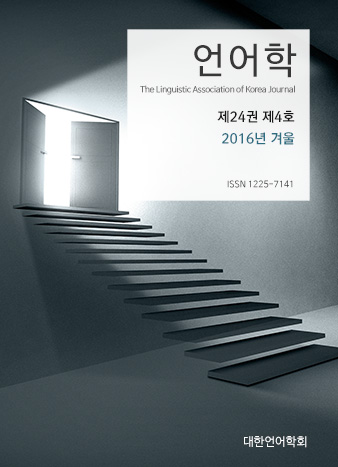대한언어학회 전자저널

-
An Alternative Approach to Realizations of the Medial [nt] Cluster in English
-
Boundary and pitch effects on the perception of Korean alveolar nasal
-
Corpus-Based English Grammar Instruction in a Korean College Context Korean College Context
-
A Study on the Relationship between Self-Efficacy Beliefs and Comprehension in English Reading
Abstract
Keywords
# 제2언어 습득(second language acquisition) # 지배범주 매개변인(Governing Category Parameter) # 부분집합원리(The Subset Principle) # 보편문법 접근(UG Access) # 재귀대명사(reflexive prono
References
- 김종복. (2009). 영어 통사 의미구조의 이해. 한국문화사. 111-116.
- 최정아. (2016). 한국인 영어학습자의 습득과정에 대한 보편문법적 접근: 재귀대명사 현상을 중심으로. 경북대학교 박사학위논문.
- Berwick, R. C. (1985). The acquisition of syntactic knowledge. MIT Press.
- Chomsky, N. (1981). On the representation of form and function. The Linguistic Review, 1(1), 3-40.
- Ellis, R. (1985). Understanding second language acquisition. Oxford: Oxford University Press.
- Hannan, M. (2004). A study of the development of the English verbal morphemes in the grammar of 4-9 year old Bengali-speaking children in the London borough of Tower Hamlets. Unpublished doctoral dissertation. University of Essex.
- Joo, H. R. (2003). Second language learnability and the acquisition of the argument structure of English locative verbs by Korean speakers. Second Language Research, 19(4), 305-328.
- MacLaughlin, D. (1993). Second language acquisition and the subset principle. Annual Boston University Conference on Language Development, 17. Boston. MA.
- Pinker, S. (1989). Learnability and cognition: The acquisition of argument structure. MIT Press.
- Selinker, L. (1972). Interlanguage. IRAL-International Review of Applied Linguistics in Language Teaching, 10(1-4), 209-232.
- Wexler, K., & Manzini, M. R. (1987). Parameters and learnability in binding theory: Parameter setting. Springer Netherlands, 41-76.
- White, L. (1989b). Universal grammar and second language acquisition (Vol. 1). John Benjamins Publishing.